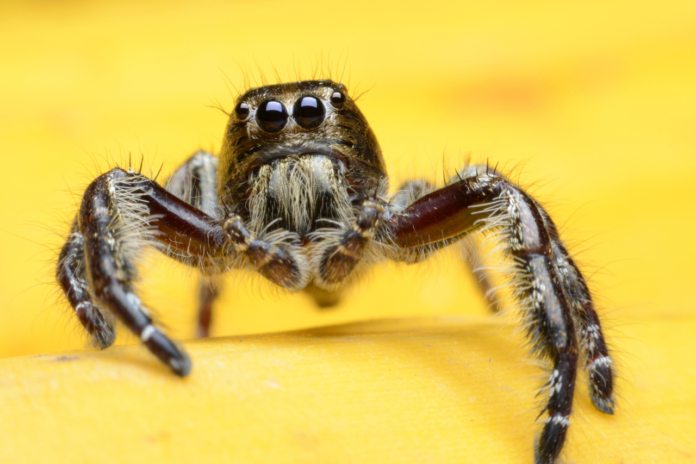While cats and dogs may be the more traditional choices for pets, some enthusiasts are drawn to the unique charm and beauty of jumping spider pet. These tiny arachnids are captivating creatures known for their agility, intelligence, and captivating hunting techniques, making them intriguing companions for those willing to explore the world of unconventional pets.
Fascinating Characteristics of Jumping Spiders
Appearance and Size
Despite their diminutive size, jumping spiders boast an impressive array of colors and patterns, ranging from vibrant hues to intricate markings. Their compact bodies and large, forward-facing eyes give them a distinctly adorable appearance that belies their predatory nature.
Intelligence and Behavior
Jumping spiders are renowned for their intelligence and curious nature. They exhibit complex behaviors such as problem-solving, learning, and even social interactions, making them fascinating subjects for observation and study.
Unique Hunting Techniques
Unlike other spiders that rely on webs to catch prey, jumping spider pet are active hunters who rely on their agility and keen eyesight to stalk and pounce on unsuspecting insects. Their lightning-fast reflexes and precise movements make them highly effective predators in the miniature world they inhabit.
Care and Maintenance of Jumping Spider Pets
Habitat Setup
Creating a suitable habitat for a jumping spider pet is relatively simple. A small enclosure with ample ventilation, the substrate for burrowing, and climbing surfaces such as twigs or artificial plants will provide a comfortable environment for your spider to thrive.
Feeding and Nutrition
Jumping spiders are carnivorous hunters who feed primarily on small insects such as fruit flies, crickets, or flies. Providing a varied diet of live prey ensures that your spider receives essential nutrients and maintains optimal health.
Handling and Interaction
While jumping spiders can be fascinating to observe, they are best admired from a distance. Handling should be kept to a minimum to avoid stressing the spider or causing injury. Instead, interact with your spider through gentle movements and observation from outside the enclosure.
Benefits of Keeping Jumping Spider Pets
Educational Opportunities
Keeping a jumping spider pet can be a valuable educational experience, especially for children interested in biology and natural sciences. Observing the spider’s behavior, hunting strategies, and interactions with its environment can foster a deeper appreciation for the natural world.
Therapeutic Effects
Studies have shown that interacting with pets can have therapeutic benefits for humans, including reducing stress and anxiety levels. The quiet presence of a jumping spider pet can provide comfort and relaxation, especially for individuals seeking solace in nature.
Low Maintenance Requirements
Compared to traditional pets such as cats or dogs, jumping spider pet have relatively low maintenance requirements. They require minimal space, do not produce noise or odor, and can thrive on a diet of live insects, making them an ideal choice for individuals with busy lifestyles or limited living space.
Tips for Choosing a Jumping Spider as a Pet
Researching Species
Before acquiring a jumping spider pet, research different species to determine which best suits your preferences and experience level. Consider factors such as size, temperament, and habitat requirements when selecting a species.
Selecting a Healthy Spider
When purchasing a jumping spider, choose specimens that appear active, alert, and free from any signs of illness or injury. Avoid spiders with abnormalities such as missing limbs or lethargic behavior, as these may indicate underlying health issues.
Obtaining Necessary Supplies
Ensure you have all the necessary supplies and equipment before bringing home a jumping spider pet. This includes an appropriate enclosure, substrate, climbing surfaces, live prey, and any other accessories needed to create a comfortable and enriching environment for your spider.
Conclusion
In the world of unconventional pets, jumping spiders stand out as fascinating and captivating companions for enthusiasts of all ages. With their unique characteristics, low maintenance requirements, and educational value, jumping spiders offer a rewarding and enriching pet ownership experience for those willing to explore the wonders of the arachnid world.
FAQs
- Are jumping spiders venomous?
- While jumping spiders possess venom for subduing their prey, their venom is not harmful to humans and is considered relatively harmless.
- Do jumping spiders require special lighting or heating in their enclosures?
- Jumping spiders do not require special lighting or heating in their enclosures. Room temperature is typically sufficient for their needs, and exposure to direct sunlight should be avoided to prevent overheating.
- How often should I feed my jumping spider pet?
- Jumping spiders should be fed small prey items such as fruit flies or crickets every few days to maintain their health and vitality. Monitor your spider’s appetite and adjust feeding frequency accordingly.
- Can jumping spiders coexist with other pets, such as cats or dogs?
- While jumping spiders pose no threat to larger pets such as cats or dogs, it’s essential to supervise interactions between pets to prevent accidents or injuries. Exercise caution and ensure that all pets are safely separated when not under supervision.
- Are jumping spider pet suitable pets for children?
- Jumping spiders can make fascinating pets for children interested in insects and arachnids. However, adult supervision is recommended to ensure the safety of both the child and the spider during handling and observation.
Also Read: pet friendly apartments

